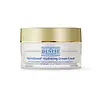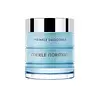What's inside
What's inside
 Key Ingredients
Key Ingredients

 Benefits
Benefits

 Concerns
Concerns

 Ingredients Side-by-side
Ingredients Side-by-side

Water
Skin ConditioningHydrogenated Polyisobutene
EmollientCyclopentasiloxane
EmollientCetearyl Alcohol
EmollientGlyceryl Stearate
EmollientGlycerin
HumectantDimethiconol
EmollientRetinol
Skin ConditioningCeramide Ns
Skin ConditioningPalmitoyl Oligopeptide
CleansingOryza Sativa Extract
AbsorbentHexapeptide-9
Skin ConditioningDipeptide-4
Skin ConditioningGlycolipids
Skin ConditioningGlycine Soja Oil
EmollientLecithin
EmollientEthylhexyl Cocoate
EmollientC12-15 Alkyl Benzoate
AntimicrobialTribehenin
EmollientDimethicone
EmollientCeteareth-20
CleansingLaureth-7
EmulsifyingParfum
MaskingPolyacrylamide
C13-14 Isoparaffin
EmollientCI 16035
Cosmetic ColorantCI 19140
Cosmetic ColorantTriethanolamine
BufferingDisodium EDTA
Phenoxyethanol
PreservativeEthylhexylglycerin
Skin ConditioningWater, Hydrogenated Polyisobutene, Cyclopentasiloxane, Cetearyl Alcohol, Glyceryl Stearate, Glycerin, Dimethiconol, Retinol, Ceramide Ns, Palmitoyl Oligopeptide, Oryza Sativa Extract, Hexapeptide-9, Dipeptide-4, Glycolipids, Glycine Soja Oil, Lecithin, Ethylhexyl Cocoate, C12-15 Alkyl Benzoate, Tribehenin, Dimethicone, Ceteareth-20, Laureth-7, Parfum, Polyacrylamide, C13-14 Isoparaffin, CI 16035, CI 19140, Triethanolamine, Disodium EDTA, Phenoxyethanol, Ethylhexylglycerin
Water
Skin ConditioningCyclopentasiloxane
EmollientIsodecyl Neopentanoate
EmollientHydrogenated Polyisobutene
EmollientGlycerin
HumectantButylene Glycol
HumectantIsohexadecane
EmollientStearic Acid
CleansingCetyl Alcohol
EmollientNylon-12
Glyceryl Stearate
EmollientStearyl Alcohol
EmollientDimethicone
EmollientGlyceryl Polymethacrylate
Acetyl Hexapeptide-8
HumectantPalmitoyl Tripeptide-1
Skin ConditioningSerine
MaskingGlycine
BufferingProline
Skin ConditioningPalmitoyl Carnitine
Skin ConditioningAlanine
MaskingGlutamic Acid
HumectantCamellia Sinensis Leaf Extract
AntimicrobialCalluna Vulgaris Flower Extract
Skin ConditioningCentella Asiatica Extract
CleansingRetinyl Palmitate
Skin ConditioningTocopheryl Acetate
AntioxidantAscorbyl Palmitate
AntioxidantPCA
HumectantPhospholipids
Skin ConditioningChamomilla Recutita Flower Extract
MaskingEchinacea Purpurea Extract
MoisturisingPEG-20 Stearate
EmulsifyingPEG-100 Stearate
Dimethicone Crosspolymer
Emulsion StabilisingBisabolol
MaskingAcrylates/C10-30 Alkyl Acrylate Crosspolymer
Emulsion StabilisingXanthan Gum
EmulsifyingEthoxydiglycol
HumectantLecithin
EmollientGlucose
HumectantLactic Acid
BufferingTriethanolamine
BufferingPropylene Glycol
HumectantDisodium EDTA
Phenoxyethanol
PreservativeDiazolidinyl Urea
PreservativeWater, Cyclopentasiloxane, Isodecyl Neopentanoate, Hydrogenated Polyisobutene, Glycerin, Butylene Glycol, Isohexadecane, Stearic Acid, Cetyl Alcohol, Nylon-12, Glyceryl Stearate, Stearyl Alcohol, Dimethicone, Glyceryl Polymethacrylate, Acetyl Hexapeptide-8, Palmitoyl Tripeptide-1, Serine, Glycine, Proline, Palmitoyl Carnitine, Alanine, Glutamic Acid, Camellia Sinensis Leaf Extract, Calluna Vulgaris Flower Extract, Centella Asiatica Extract, Retinyl Palmitate, Tocopheryl Acetate, Ascorbyl Palmitate, PCA, Phospholipids, Chamomilla Recutita Flower Extract, Echinacea Purpurea Extract, PEG-20 Stearate, PEG-100 Stearate, Dimethicone Crosspolymer, Bisabolol, Acrylates/C10-30 Alkyl Acrylate Crosspolymer, Xanthan Gum, Ethoxydiglycol, Lecithin, Glucose, Lactic Acid, Triethanolamine, Propylene Glycol, Disodium EDTA, Phenoxyethanol, Diazolidinyl Urea
Ingredients Explained
These ingredients are found in both products.
Ingredients higher up in an ingredient list are typically present in a larger amount.
Cyclopentasiloxane, or D5, is a silicone used to improve texture of products and trap moisture.
D5 is considered lightweight and volatile. Volatile means it evaporates quickly after application. Once evaporated, D5 leaves a thin barrier that helps keep skin hydrated.
It is also an emollient. Emollients help soften the skin and prevent water loss. Silicones create a silky texture in products. D5 helps other ingredients become more spreadable.
Studies show D5 is safe to use in skincare products. We recommend speaking with a skincare professional if you have concerns.
Learn more about CyclopentasiloxaneDimethicone is a type of synthetic silicone created from natural materials such as quartz.
What it does:
Dimethicone comes in different viscosities:
Depending on the viscosity, dimethicone has different properties.
Ingredients lists don't always show which type is used, so we recommend reaching out to the brand if you have questions about the viscosity.
This ingredient is unlikely to cause irritation because it does not get absorbed into skin. However, people with silicone allergies should be careful about using this ingredient.
Note: Dimethicone may contribute to pilling. This is because it is not oil or water soluble, so pilling may occur when layered with products. When mixed with heavy oils in a formula, the outcome is also quite greasy.
Learn more about DimethiconeDisodium EDTA plays a role in making products more stable by aiding other preservatives.
It is a chelating agent, meaning it neutralizes metal ions that may be found in a product.
Disodium EDTA is a salt of edetic acid and is found to be safe in cosmetic ingredients.
Learn more about Disodium EDTAGlycerin is already naturally found in your skin. It helps moisturize and protect your skin.
A study from 2016 found glycerin to be more effective as a humectant than AHAs and hyaluronic acid.
As a humectant, it helps the skin stay hydrated by pulling moisture to your skin. The low molecular weight of glycerin allows it to pull moisture into the deeper layers of your skin.
Hydrated skin improves your skin barrier; Your skin barrier helps protect against irritants and bacteria.
Glycerin has also been found to have antimicrobial and antiviral properties. Due to these properties, glycerin is often used in wound and burn treatments.
In cosmetics, glycerin is usually derived from plants such as soybean or palm. However, it can also be sourced from animals, such as tallow or animal fat.
This ingredient is organic, colorless, odorless, and non-toxic.
Glycerin is the name for this ingredient in American English. British English uses Glycerol/Glycerine.
Learn more about GlycerinGlyceryl Stearate is a mix of glycerin and stearic acid.
It is used to stabilize the mixing of water and oil ingredients. By preventing these ingredients from separating, it can help elongate shelf life. It can also help thicken the product's texture.
As an emollient, it helps soften skin and supports barrier-replenishing ingredients.
In cosmetics, Glyceryl Stearate is often made from vegetable oils or synthetically produced.
This ingredient may not be fungal-acne safe
Fun fact: The human body also creates Glyceryl Stearate naturally.
Learn more about Glyceryl StearateHydrogenated Polyisobutene is a synthetic polymer. Polymers are compounds with high molecular weight. Hydrogenated Polyisobutene is an emollient and texture enhancer.
In one study, Hydrogenated Polyisobutene showed better skin hydration levels than Caprylic/Capric Triglyceride. As an emollient, it helps keep your skin soft and hydrated by trapping moisture in.
Hydrogenated Polyisobutene is often used as a mineral oil replacement.
Learn more about Hydrogenated PolyisobuteneLecithin is a term for a group of substances found in the cell membranes of plants, animals, and humans. They are made up of mixture of phospholipids.
This ingredient has emollient and emulsifying properties.
As an emollient, lecithen helps soften the skin and creates a barrier to keep moisture in.
As an emulsifier, it also helps prevent water and oil ingredients from separating. Lecithin can also help ingredients be better absorbed by the skin.
This is because the phospholipids in lecithin produce liposomes. Liposomes help other ingredients get through the skin barrier.
Depending on the source of this ingredient, lecithin may not be fungal acne safe. This is because some sources of lecithin come from soybean oil, which may feed the malassezia yeast that feeds fungal acne.
We recommend reaching out to the brand you are purchasing from to inquire about the source of their lecithin.
Some other names for this ingredient include soy lecithin and deoiled soy lecithin.
Learn more about LecithinPhenoxyethanol is a preservative that has germicide, antimicrobial, and aromatic properties. Studies show that phenoxyethanol can prevent microbial growth. By itself, it has a scent that is similar to that of a rose.
It's often used in formulations along with Caprylyl Glycol to preserve the shelf life of products.
Triethanolamine is an emulsifier and pH adjuster. It is created using ethylene oxide and ammonia. This gives Triethanolamine a nitrogen core and a similar scent to ammonia.
As an emulsifier, it prevents ingredients from separating and enhances texture by adding volume to a product.
PH adjusters are common in cosmetic products. The pH of a product can affect the effectiveness of other ingredients. A product with a high pH may also irritate the skin.
Learn more about TriethanolamineWater. It's the most common cosmetic ingredient of all. You'll usually see it at the top of ingredient lists, meaning that it makes up the largest part of the product.
So why is it so popular? Water most often acts as a solvent - this means that it helps dissolve other ingredients into the formulation.
You'll also recognize water as that liquid we all need to stay alive. If you see this, drink a glass of water. Stay hydrated!
Learn more about Water